The post below is from the website I belong to called TurfNet. Once a week they sample member blogs and compile a few in an email. We have been featured a couple of times. An interesting one from our sister island is related to a post I was going to make this week.

Brushcutting and tree removal...
Frank Duda, asst supt, Miacomet Golf Club, Nantucket, MA:

"It is really hard to believe that it is almost the middle of December and the weather is still so pleasant. While we all know that this run of good weather must come to an end at some point the maintenance staff has taken this opportunity to accomplish a great deal of work. The tasks we have completed will ultimately land us in a position where we are set to come out of winter and into the spring of 2012 in really good shape.
We have begun the daunting task of tree and brush removal on several of the holes.
We have begun the daunting task of tree and brush removal on several of the holes.
"Nantucket, Martha’s Vineyard and Tuckernuck are home to 90% of the world’s sandplain grasslands..."
|
By removing any woody plants and some trees we hope to encourage the growth of both native plants and grasses. Nantucket, Martha’s Vineyard and Tuckernuck are home to 90% of the world’s sandplain grasslands, and our intent is to keep them as such. The Nantucket Island Land Bank is in charge of maintaining a majority of these sandplain grasslands, which they preserve by either mowing or burning the area yearly. Miacomet follows the same protocol as the Land Bank when it comes to maintaining these areas.
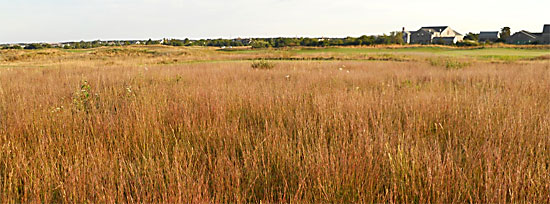
Little Bluestem #6 Tee
If an area is left undisturbed some of the woody plants that begin to appear are considered invasive species by the state of Massachusetts. In particular, Japanese Black Pine Trees are very aggressive growers and dominate once vast sandplain grasslands if given the opportunity. By removing invasive species we are allowing areas to return to a healthy balance of native species.
One particular area on the golf course where you could see the transformation of a sandplain grassland into a woodland was between five and six, where in addition to Japanese Black Pine Trees, Eastern Red Cedar Trees, Scrub Oak and Northern Bayberry started to dominate the area. Once we removed all the trees and woody vegetation we noticed that there is a healthy amount of native grasses that were in the area. By removing the trees and woody plants the area should return to a sandplain grassland over the course of the next couple of years. One area where a grassland restoration was successful is around 6 tees. This area used to be dominated by woody plants. Over the course of several years, and multiple burns and mows the area is currently dominated by native grass species.
One particular area on the golf course where you could see the transformation of a sandplain grassland into a woodland was between five and six, where in addition to Japanese Black Pine Trees, Eastern Red Cedar Trees, Scrub Oak and Northern Bayberry started to dominate the area. Once we removed all the trees and woody vegetation we noticed that there is a healthy amount of native grasses that were in the area. By removing the trees and woody plants the area should return to a sandplain grassland over the course of the next couple of years. One area where a grassland restoration was successful is around 6 tees. This area used to be dominated by woody plants. Over the course of several years, and multiple burns and mows the area is currently dominated by native grass species.
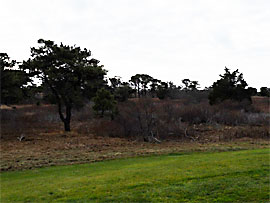 Behind #3 green before... Behind #3 green before... | 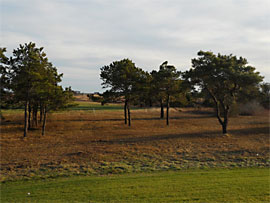 After. |
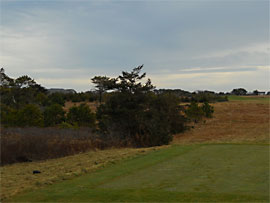 View from #5 Gold tee, before... | 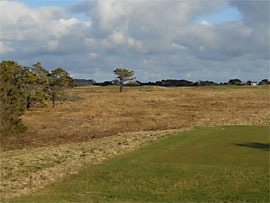 After. |
Our hope is that over the course of several years we can restore once vast sandplain grasslands into thriving grasslands again. We will also continue to mow and burn the grasslands we have to ensure their continued presence on the golf course. In addition to the ecological benefits of these activities many golfers will notice the enhanced views of both the golf course and the island. So far we have removed brush and trees on holes 2, 3, 4, 5, 6, and 9. We will continue to remove trees and brush throughout the winter on selected areas."
Visit the Miacomet blog at miacometmaintenance.blogspot.com.
We have some interesting features in Mink Meadows that relate to the original design. In the clubhouse is the original routing plan from 1936 for 18 holes. One story I heard is that all the fairways were cleared back in the day. Certainly the tenth fairway which cut up through the middle of the rectangle has been maintained for all these years. Mr. David Currier, one of our first landowners and MMA Presidents mowed this patch of land to maintain his water view. His daughter Susan continues the tradition. I mowed it with the bobcat brush cutter a couple of summers ago and again this week. I was amazed at the density of black pines. After reading the blog post above I feel duty bound to try and convert this back to grasslands. I can honestly say the black pine is not my favorite tree and if every last one in Mink Meadows was removed I would not shed a tear. The blog post and pictures above tell the story better than I ever could and show what I have had for a vision of some of the areas I am trying to convert from woods to fescue areas here at MM.
 |
| mowing the "tenth" fairway |
 |
| view back towards clubhouse |
 |
| View from Currier deck on Hilltop road |
The pictures above look down over the Turf Maint. Facility to the sound beyond. It gives a slight glimpse of what the course might have looked like when constructed and leaves one to wonder how spectacular the views must have been. Below are pictures taken of a couple of the aerial photos in clubhouse:
 |
| "10th" fairway to right of flash |
 |
| vintage photo notice how much wider the cleared "10th" is |
 |
| close up. looking towards town in both |
All the current pictures show a good sized patch of woods between the field and the golf course. These trees are expanding in number and size and are in the process of being tweaked as I write this to maintain this view. Creating and maintaining a water view is no small feat, especially when the trees are allowed to grow up to maturity. The view channel often crosses property lines and ownership changes so these relationships are constantly in flux. The mowing of the "10th' fairway for all of these years may have been done for selfish reasons to maintain a view but I for one am glad that we have this piece of history of the course preserved and am honored to play a small role in seeing it continue.
No comments:
Post a Comment